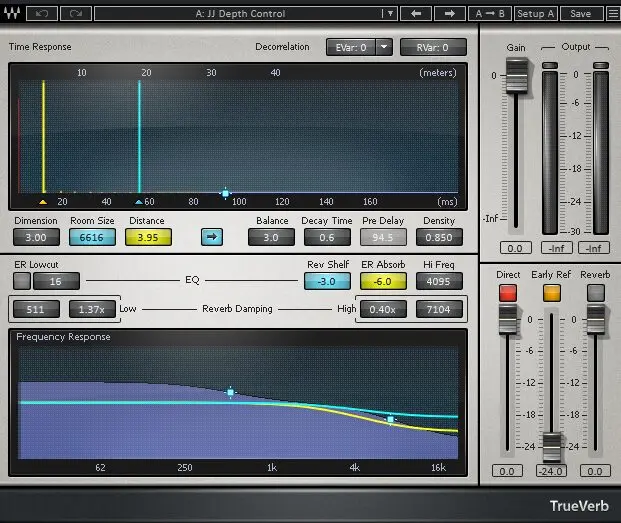Jaycen Joshua’s Waves Trueverb trick is a smart way to add depth using reverb, but not the usual way.
Instead of creating a wash of space, it helps you place sounds exactly where you want them — front or back — without losing punch.
You get cleaner mixes and more control.
No need to automate volume or EQ. Just one reverb, set up right.
What is depth (front to back panning)?
Depth means how close or far a sound feels in the mix. You’re not moving sounds left or right—you’re moving them forward or backward.
A close sound feels loud, dry, and detailed.
A far sound feels quiet, soft, and roomy.
With the right tools, you can control this without changing the sound too much.
How the Jaycen Joshua Trueverb Trick Works
The Waves Trueverb plugin has an early reflection and reverb tail.
Most people use both.
Jaycen only uses the early reflections.
That’s the key.
Early reflections tell your ears how far a sound is — without washing it in reverb.
You set up Trueverb so the early reflections are strong and short. This gives the sound space, but it stays tight and forward.
If you lower the level of the early reflections, the sound moves back. If you raise them, the sound comes forward.
This sounds amazing when used together with the famous Jaycen Joshua Vocal Chain.
How to Set Up the Trueverb Trick (Step-by-Step)

You’ll use Trueverb directly on the mix tracks.
This gives you more control over how each sound feels in the space.
Step 1: Add Trueverb on a Track
Pick a sound you want to place in the mix — supporting vocals, snare, guitar, or pad.
Load Waves Trueverb as an insert on that track.
This means the sound will pass through the plugin, and you’ll directly control how much space it has.
Step 2: Turn Off the Reverb Tail
Inside Trueverb, go to the Reverb section.
Set the reverb time to zero. Then turn the reverb level all the way down — usually to minus infinity or the lowest it goes.
This removes the reverb tail completely. You’re now only using the early reflections.
That’s the core of the Jaycen Joshua Trueverb trick — creating depth using reflections only, without a long, spacey reverb wash.
Step 3: Dial In the Reflections
Now shape how the reflections behave.
Use the distance parameter on the plugin to control how far back you want to place the sound in the mix.
The room size is usually at around 6000, but you can increase this to push sounds further at the back.
Step 4: Repeat on Other Tracks
Repeat this setup on any track you want to place in the stereo field — without affecting its punch or stereo image.
For foreground elements like vocals or snares, keep the ER level higher.
For background elements like pads, harmonies, or textures, keep it lower.
Since each track has its own Trueverb insert, you can fine-tune each sound’s space without sharing one reverb setting across everything.
Add Movement by Automating Early Reflections
Once you’ve placed each track using the early reflections, you can push the mix even further by automating the ER level.
This is a subtle way to bring sounds forward during key moments — like choruses, drops, or vocal phrases — without changing the volume.
For example, you can raise the ER Level slightly on a lead vocal during the hook.
It feels like it steps forward and grabs more attention. Then, pull it back during verses to give space to other elements.
This technique keeps your mix breathing. It’s one of the reasons the Jaycen Joshua TrueVerb trick works so well —you’re mixing depth and emotion at the same time.
If you enjoyed this tutorial, you should also check out Michael Brauer's parallel vocal compression technique.